Done for 2009: The Holiday MacBook Pro Roundup
by Anand Lal Shimpi on November 10, 2009 12:00 AM EST- Posted in
- Mac
Performance
Benchmarking under OS X is a bit of a pain. There aren't many good standardized real world benchmarks, and unfortunately the synthetic tests are often over used.
General OS usage is a difficult thing to quantify, but one measure of performance has always been the number of bounces an icon in the dock makes before an application loads. I decided to take it to the next level and write a quick script to launch 15 applications in a row, timing how long the entire process takes.
I launched, in order: Mail, Safari, Activity Monitor, iTunes, iCal, DVD Player, iPhoto, Photo Booth, Quicktime Player, Disk Utility, Preview, iMovie, Front Row, Garage Band and Aperture.
The entire process stresses both the disk and CPU, which is why we see a huge improvement when going to an SSD as well as differences between CPU speeds.
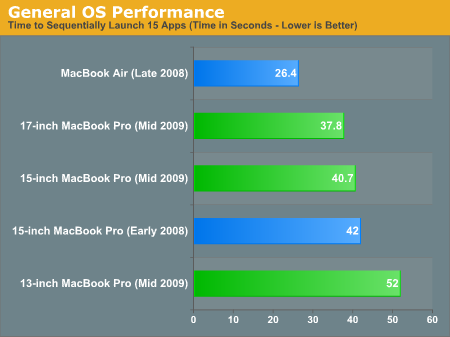
The 13-inch MacBook Pro performs the worst here by a large margin, not just because of its lowly 2.26GHz Core 2 Duo, but also because it only has 2GB of memory. The 13-inch system takes nearly 30% longer to load all of the apps because of its limited amount of memory.
The 15-inch MacBook Pro uses a 2.53GHz Core 2 Duo instead of the 2.80GHz chip in the 17-inch by default. The result is a 7% longer load time on the 15-inch system, not huge, but not insignificant. As always, I recommend getting the fastest CPU you can afford if you're planning on keeping this machine for a while.
The fastest machine here is actually the MacBook Air, because it comes with an SSD. Your best bet to improve overall system responsiveness and launch times is to get a good SSD. Even with only 2GB of memory, the current gen MacBook Air finishes the script faster than the 17-inch MacBook Pro. Paired with an Intel X25-M G2 the 15-inch MacBook Pro can run through our script in 16 seconds.
Adobe Photoshop CS4 Performance
The Retouch Artists Speed Test we use for our CPU testing under Windows also works under OS X. We're running the exact same benchmark here, basically performing a bunch of image manipulations and filters and timing the entire process.
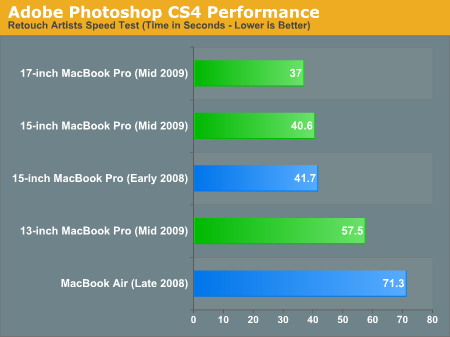
Despite limiting Photoshop to not keeping any history, the 2GB 13-inch MacBook Pro takes around 40% longer to complete the test than the 15-inch MacBook Pro. If you're planning on doing any Photoshop work you'll want to upgrade the 13-inch system to 4GB of memory.
The slower CPU in the 15-inch system penalizes it by around 10% compared to the 17-inch MacBook Pro. For any sort of real performance work, it looks like a 15-inch MacBook Pro with the 2.80GHz upgrade would be a good balance of price/performance.
As I alluded to earlier, there's not much of a performance improvement from the early 2008 MacBook Pro to the current generation. Drive speeds have improved a bit but overall performance hasn't really gone up, it's why Apple had to rely on updated looks and much better battery life to sell systems this time around. Not a bad tradeoff if you ask me, you'll see the performance improvement next year with Arrandale.
Aperture 2 RAW Import
For my Aperture test I simply timed how long it took to import 203 12MP RAW images into the library.
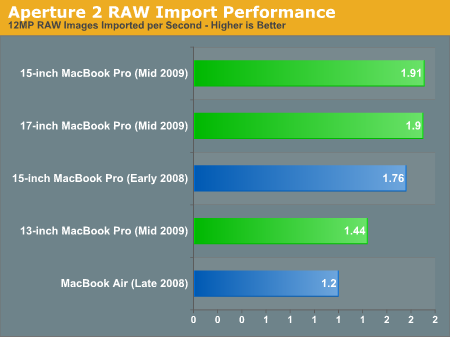
Once again, 2GB isn't enough, the 15-inch and 17-inch are indistinguishable but the 13-inch system takes much longer here.
Cinebench R10
3D rendering performance is mostly CPU bound so the 13-inch system isn't penalized by its memory limitations. Here the 2.53GHz Core 2 Duo is around 11% faster than the 2.26GHz in the 13-inch MBP. The 2.80GHz CPU is another 11% faster on top of that.
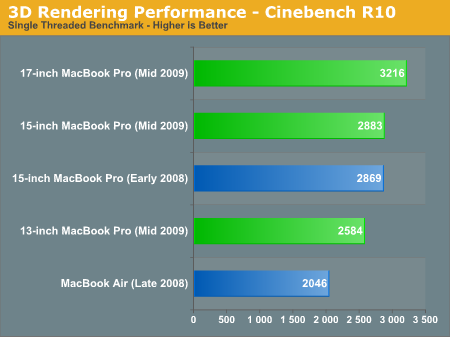
In the multithreaded bench the performance advantages are about the same, a bit closer to 12% between chips.
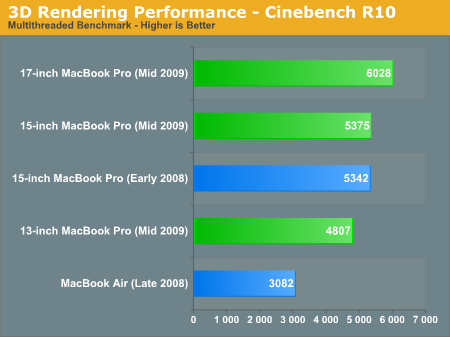
Again we see that CPU speed hasn't really improved much since early 2008, the two 15-inch systems are basically equal performers here.
Quicktime H.264 Video Encoding
Our final benchmark is more consumer focused. Here I'm taking an XviD and converting it to an iPhone-supported H.264 format.
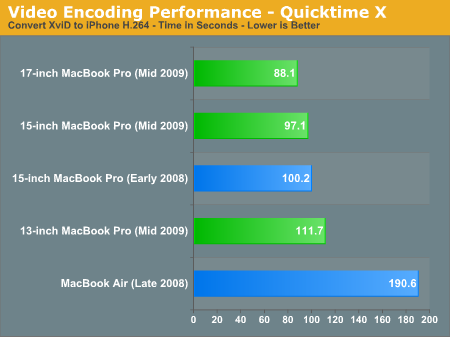
We're CPU bound here so the 13-inch system only takes 14% longer to convert our video clip than the 15-inch. The difference between the 15-inch and 17-inch is about another 10%.










115 Comments
View All Comments
nangryo - Saturday, November 14, 2009 - link
Do you realize the PC hardware you mention to replace MAC product is equivalent in price or even worse, more expensive (Adamo, AlienWare) please stop trolling. If you don't like it, don't read it. No one force you to come here and whine like a crybaby.
tuskers - Tuesday, November 17, 2009 - link
I love your argument-- "you bring up competition in a similar price range, so you must be a troll." You're using the traditional PC-versus-Mac argument of "PCs cost less!", except with even less basis.I want to read a fair comparison of Mac versus the competition, not a slaughter of value-designed PCs. Mac very well might be the best out there-- I think it's pretty well conceded that Macs win on battery life, and OS X certainly has those that swear by it. And I'm absolutely fine with those sections of the article.
This simply isn't an Apples-to-apples comparison. I'm not saying the other companies' brands are better-- what I'm saying is, Apple produces products with a specific type of user in mind-- one at the mid-to-upper performance range (in terms of hardware), with as much dedication to form-factor as it has to functionality. Yes, I expect other companies to ask
If I go shopping for a luxury car, I don't compare Lexus to Honda and Chevy, I compare Lexus to Acura and Cadillac. Similarly, I don't compare $1100 computers with $2500 computers. But you don't even need to escalate past $1000 to find the MSI X600 or GX720. Adamos cost more than 13" Macbooks, but they also ship standard with SSDs, higher screen resolution, and slimmer chassis (although with disadvantages as well). The Envy ships with more horsepower in a similar form-factor for slightly more money (much less than some of the disparities in the article).
These are the compare/contrast elements that make for interesting decisions, rather than a "look at the shiny Macs!" article.
I'll take back the implication that this might have been a "sponsored" article, but it's simply the first thought I had after I read it.
The0ne - Thursday, November 12, 2009 - link
As I said earlier it seems Anand is all "giddy" because he got a new toy to play with. That excitement alone causes all sorts of things :D fun things in most cases hahahaI can't help but agree with your comments. After reading others comments I'm not only shock at Anand but at some users supporting the $2500 MacBook to no end. If I had the money or my company allows the spending I would like to have one, of course. But it's really not practical at all when you have so many other choices in the market.
blufire - Wednesday, November 11, 2009 - link
Just released.. may address the excessive battery drain for 64-bit Safari with 32-bit Flash.citan x - Wednesday, November 11, 2009 - link
Why does it feel that there is too much Mac pro coverage? Most of the info on here has already been available. Why a full blown article on them now?Also, why wasn't the new Asus UL80 that was just reviewed compared here. What I would like to know is how the Asus UL80 compares to the 13" Mac when both have an SSD.
The 17" Macbook Pro is nice, but just too expensive.
mitaiwan82 - Wednesday, November 11, 2009 - link
Good article, but the product shots are a bit overexposed for my taste. The MBPs almost blend into the white background of the site.blufire - Wednesday, November 11, 2009 - link
The image of the 15" MBP on page 3 appears to be a 17".Thanks for the article!
JimmiG - Wednesday, November 11, 2009 - link
I hate it how Apple doesn't use the extra space of the 15" and 17" models to put in a better keyboard and a numpad. My 15" HP Probook comes with big, nicely spaced keys that use all the available space, and they even managed to cram in a numpad without making things look cramped or crowded.The 17" Macbook looks absolutely ridiculous with that *huge* emptiness around the tiny keyboard. I see they no longer include a numpad on the keyboard that comes with the iMac, either. I guess it's to show the world that Macs are "fun", while PCs are only used for Excel and stuff...but still, some of use need to be boring from time to time, and then a numpad is a must.
MrPete123 - Wednesday, November 11, 2009 - link
Anand, I heard there were unofficial ways of running MacOS X on standard PCs... would it be possible to do this and do battery tests to see how it handles it? I'm really interested to know what Apple's doing to make their OS so power efficient.Maybe it disallows C-states or something in their BIOS for non-OSX operating systems?
nangryo - Saturday, November 14, 2009 - link
Not, it's not possible, at least in a formal/official benchmark / reporting. Because it would face legal problem etc etc.He may do it unofficially though.